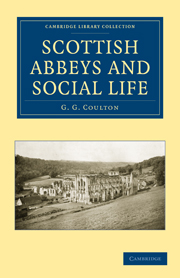Book contents
- Frontmatter
- Contents
- LIST OF ILLUSTRATIONS
- Preface
- Chapter I Celtic Monachism
- Chapter II The Monastic Rules
- Chapter III Monastic Revenues
- Chapter IV How Endowments Came (I)
- Chapter V How Endowments Came (II)
- Chapter VI Monks and Parishes (I)
- Chapter VII Monks and Parishes (II)
- Chapter VIII Charity (I)
- Chapter IX Charity (II)
- Chapter X Monk and Peasant (I)
- Chapter XI Monk and Peasant (II)
- Chapter XII Monastic Housekeeping
- Chapter XIII Church and Scriptorium
- Chapter XIV The Monastic Chronicler
- Chapter XV Schools
- Chapter XVI Art and Learning
- Chapter XVII Professions and Business
- Chapter XVIII Visitation (I)
- Chapter XIX Visitation (II)
- Chapter XX A Voice from the Cloister
- Chapter XXI Conclusion
- Appendixes
- List of Authorities
- Index
Chapter VII - Monks and Parishes (II)
Published online by Cambridge University Press: 05 August 2011
- Frontmatter
- Contents
- LIST OF ILLUSTRATIONS
- Preface
- Chapter I Celtic Monachism
- Chapter II The Monastic Rules
- Chapter III Monastic Revenues
- Chapter IV How Endowments Came (I)
- Chapter V How Endowments Came (II)
- Chapter VI Monks and Parishes (I)
- Chapter VII Monks and Parishes (II)
- Chapter VIII Charity (I)
- Chapter IX Charity (II)
- Chapter X Monk and Peasant (I)
- Chapter XI Monk and Peasant (II)
- Chapter XII Monastic Housekeeping
- Chapter XIII Church and Scriptorium
- Chapter XIV The Monastic Chronicler
- Chapter XV Schools
- Chapter XVI Art and Learning
- Chapter XVII Professions and Business
- Chapter XVIII Visitation (I)
- Chapter XIX Visitation (II)
- Chapter XX A Voice from the Cloister
- Chapter XXI Conclusion
- Appendixes
- List of Authorities
- Index
Summary
In these circumstances, the question of tithes produced more quarrels, probably, than any other. The extreme case here is well known: it was in 1222, when the pope sent a “mandate to the bishops of St Andrews, Glasgow, Dunkeld, and Dunblane (Dublinen), to issue sentences of excommunication and interdict against the persons and lands of those who stripped, beat, stoned, mortally wounded with a fork, and burned the bishop of Caithness, between whom and these parishioners a question had arisen about tithes and other rights of his church”. I know of no other exact parallel to this in any country; but in every instance where we can count up the proportion of law-cases, we find that tithes stand at or near the head. The geographical and cultural conditions of Scotland made the collection of these dues even more difficult than in most countries. The Register of Glasgow contains two very significant documents of about 1160, addressed to the Archbishop of York and the Church of Scotland. King Malcolm in one, and Pope Alexander III in the other, fulminate against the withholding of tithes, under threat of severe temporal and spiritual penalties.
Further difficulties were created, in process of time, by abusive methods of collection. For the abbey of Paisley,
the tithes were payable at the various churches, and occasionally, as we learn from the Rental-book, were gathered by a person residing at the church, who received, for his trouble in collecting them and bringing them to Paisley, a piece of land at a very moderate rent. […]
- Type
- Chapter
- Information
- Scottish Abbeys and Social Life , pp. 91 - 99Publisher: Cambridge University PressPrint publication year: 2010First published in: 1933

